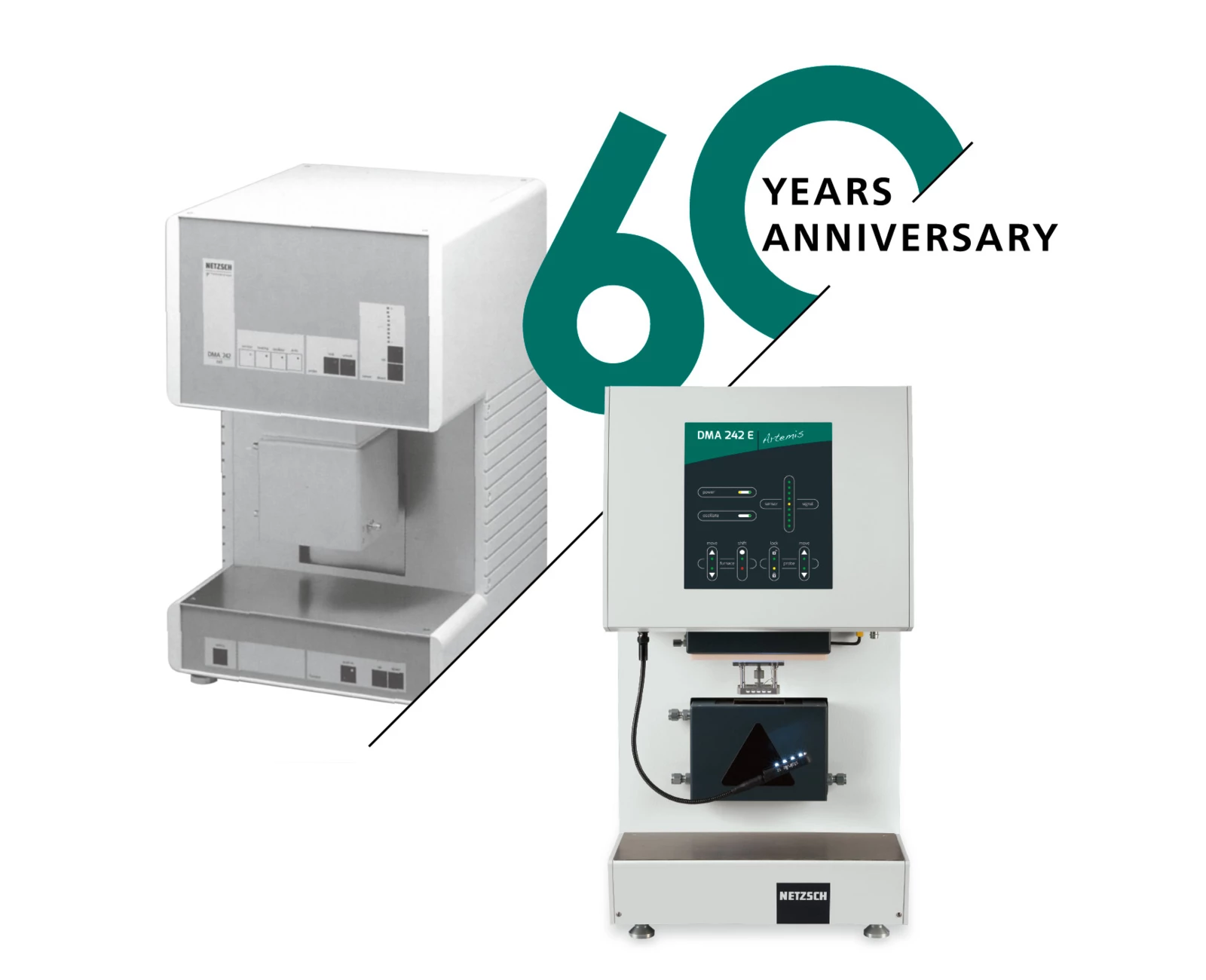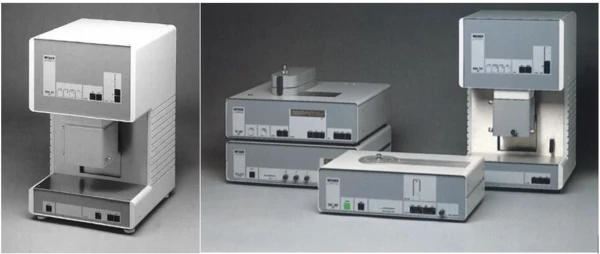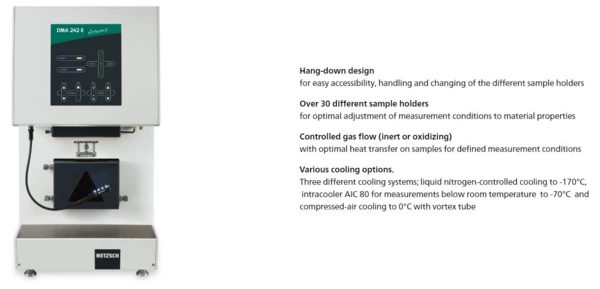
05.10.2022 by Aileen Sammler
60 Years of NETZSCH-Gerätebau: The history of the Dynamic-Mechanical Analysis
Ideal elastic behavior, i.e., the complete and immediate return to initial shape once the application of force is removed, exists only in theory. In practice, all materials’ properties are a function of frequency, which can be either more pronounced or less so due to internal friction. This behavior is called viscoelastic.
Dynamic mechanical analysis (DMA) is an indispensable method for the determination of the viscoelastic properties of mostly polymer materials such as reinforced and unreinforced thermoplastics, duromers or elastomers. With this analysis method, mechanical properties can be quantitatively examined as a function of temperature, time and frequency of an applied oscillating sample load.
In the month of October, we will be reporting on the history of the DMA and unveiling details about our broad DMA product portfolio and its multifaceted applications in quality assurance, research and development.
As we already reported in the past months of our year-long NETZSCH-Gerätebau 60-year-anniversary campaign, NETZSCH was initially specialized only in the high-temperature range, i.e., ceramics, glass, metals and building materials. Later, the company also wanted to become active in the expansive polymer sector and thus got intensively involved in the low-temperature range. For the comprehensive analysis of polymers, dynamic-mechanical analysis (DMA) was needed along with the DSC and TGA methods - which at the time, during the beginning of the 90s, was still in need of development.

On May 7, 1992, NETZSCH-Gerätebau GmbH presented the first DMA 442 at the analytica trade show in Munich. It was renamed DMA 242 a short time later, since in the meantime, the instrument 200 series consisting of DMA, DSC 200 and TG 209 had been born. With the DMA 242, also the first NETZSCH instrument based on Windows software (previously DOS-based) was developed! The DMA 242 covered the temperature range from -150°C to 600°C – already broad for its time.
The objective was to determine the viscoelastic properties of polymers and composites, or specifically the complex E modulus (storage modulus E’, Viscous modulusThe complex modulus (viscous component), loss modulus, or G’’, is the “imaginary” part of the samples the overall complex modulus. This viscous component indicates the liquid like, or out of phase, response of the sample being measurement. loss modulus E”), loss factor tan δ (tan delta), and thermal Phase TransitionsThe term phase transition (or phase change) is most commonly used to describe transitions between the solid, liquid and gaseous states.phase transitions such as the Glass Transition TemperatureThe glass transition is one of the most important properties of amorphous and semi-crystalline materials, e.g., inorganic glasses, amorphous metals, polymers, pharmaceuticals and food ingredients, etc., and describes the temperature region where the mechanical properties of the materials change from hard and brittle to more soft, deformable or rubbery.glass transition. The new DMA instrument was targeted primarily toward the major automotive manufacturers and their suppliers, the electronics sector, and food technology and pharmacy.
The first instrument sold, in 1993, was supplied to South Korea. Interestingly, the application field was not in the polymer sector, but in the food sector: The new customer used the DMA to analyze gummy bears, measuring the recovery behavior to establish a correlation to chewing behavior.

Revolutionary Multi-Frequency Measurement
The first DMA only had three sample holders - for bending, compression and penetration. Later, sample holders for tension and linear shear were developed. In 1999, NETZSCH expanded the temperature range to -170°C thanks to the newly developed CC200 LN2 cooling system based on liquid nitrogen.
Absolutely revolutionary at that time was the multi-frequency measurement for creation of the so-called master curve, which was used to extrapolate a material’s behavior at frequencies beyond the measurement range. This software feature was already integrated in the standard software.
“In addition to the analysis data most frequently used in practice such as storage and Viscous modulusThe complex modulus (viscous component), loss modulus, or G’’, is the “imaginary” part of the samples the overall complex modulus. This viscous component indicates the liquid like, or out of phase, response of the sample being measurement. loss modulus along with loss factor tan δ, the software, of course, also allows for presentation of multi-tasking operation (simultaneous measurement and evaluation) as well as multi-module operation with the entire 200 series (simultaneous operation of multiple modules) …” as was stated in the NETZSCH DMA 242 brochure at that time.

Patented Technology and the Best DMA on the Market

You may remember – Stephan Knappe already familiarized us with the Milestones of DSC History in April. Here his statement on that then-revolutionary DMA 242: “The DMA was the first instrument in the company’s history with which we did not only thermally analyze, but additionally determined the mechanical properties at different forces, deformations and frequencies important for practice. The patented displacement transducer system („straine gage“) was groundbreaking at that time with its resolution of up to 0.5 nm (nanometers!)”.
Stephan Knappe has been working for us for more than 30 years. In the 90’s, he held the position of product manager for the 200 instrument series with DSC, TGA and DMA. Since NETZSCH was not that well-known in the polymer field at that time, he packed the DMA benchtop instrument into the trunk of his car and drove around to visit customers in Germany – with success: by 1995/96, we already enjoyed a high level of awareness and had the best DMA on the market.
Numerous DMA workshops followed in Germany, and later in the rest of Europe and China. Between 1996 and 2004, ever-popular DMA user meetings were held in Selb to discuss and conduct live tests on influential parameters such as frequency, force, deformation amplitude, temperature range, sample holder type, sample geometry, sample consistency, etc.
Additional instruments, the DMA 242 C and DMA 242 D, were launched in 2000 and 2013, respectively. Version C featured a five-dimensional system stiffness calibration and was used in the replacement of steel with lighter, almost-as-stiff carbon fiber-reinforced plastics in automotive applications.

Launch of the DMA 242 E Artemis
In 2013, NETZSCH launched the DMA 242 E Artemis. It features a variety of innovations:
- Higher force range: ±12 N dynamic and 12 N static
- More than 30 different sample holders
- Humidity generator: e.g., for investigating the influence of water as a plasticizer for polyamides
- Proteus®® software, compatible with other NETZSCH instruments like DSC, TGA, DIL, TMA, DEA
- Direct curve comparison with results from other NETZSCH measuring methods
Thanks to its modular design, variety of sample holders and cooling systems, the DMA 242 E Artemis is capable of covering a wide range of applications and sample conditions still today. A variety of different expansion possibilities make it an ideal instrument for any laboratory and thus a safe and long-term investment.

Learn more here: DMA 242 E Artemis - NETZSCH Analyzing & Testing
Next week, you will learn how NETZSCH entered the rubber and tire market by means of the high-load DMA. Stay tuned!